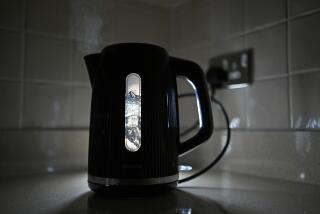2 Water Wells Closed After Chemical Is Found
Two public drinking water wells in Costa Mesa and Huntington Beach have been shut down because a suspected cancer-causing chemical was unknowingly injected into the local water supply, Orange County Water District officials said Wednesday.
NDMA, or n-nitrosodimethylamine, is a ubiquitous chemical that occurs naturally, but also is a byproduct of chlorinating water supplies to disinfect them. It is found in rocket fuel, pesticides, lubricants, cosmetics and all kinds of food, from bacon to beer and at far higher levels than turned up in local water tests.
However, with the state issuing guidelines on the chemical, water district officials shut down the wells that exceed the state limits and are exploring ways to eliminate its presence in the future.
The affected wells had pumped water into a system that served Costa Mesa and Huntington Beach. There is believed to be no threat to public health, district officials said.
âBased on testing to date and dilution at drinking water wells, [the water district] believes Orange Countyâs ground water is safe,â said William R. Mills, Jr., general manager of the water district.
NDMA as yet is not regulated by federal and state authorities. But the state Department of Health Services recently issued temporary guidelines requiring action if concentrations in drinking water exceed 20 parts per trillion. That level of exposure is expected to cause one extra cancer case per million residents who consume two liters of water per day for 70 years.
The water district first discovered the presence of the chemical last year, when it was testing its underground aquifer for pesticides and herbicides. At the water districtâs 200 wells, all met state guidelines in 1999. But last week, tests at the two wells showed concentrations of 32 to 35 parts per trillion.
The chemical can be traced to chlorinated waste water used by the district as a barrier to keep seawater from reaching underground aquifers. Chlorine, a common disinfectant used to purify water and kill pathogens, stimulates the chemical reaction that creates NDMA. In late 1999, water in the seawater intrusion barrier, itself, averaged 185 parts of NDMA per trillion, just shy of the stateâs threshold that would result in mandatory shutdown of the barrier, said Michael P. Wehner, associate general manager for water science and technology at the water district.
Levels at nearby monitoring stations were as high as 150 parts per trillion near the seawater intrusion barrier. However, Mills said the chemical was diluted as it passed through the aquifer.
Karl Kemp, general manager of Mesa Consolidated Water District, which operates one of the wells, said his agency is continuing to test the water and also is exploring ultraviolet devices to destroy the carcinogen.
These findings should not eliminate the use of chlorine as a disinfectant, stressed Robert Hultquist, chief of the drinking water technical operations section for the state health department.
âChlorine is the most effective way to control [disease-causing] microorganisms, such as bacteria, virus, parasites,â he said.
Officials must balance the risks, he said.
âIf we had un-disinfected water, 1 out of 1,000 people would get sick every year with potentially life-threatening illnesses,â Hultquist said.
(BEGIN TEXT OF INFOBOX / INFOGRAPHIC)
Water vs. Water
To prevent ocean water from mixing underground with the drinking water aquifer, the Orange County Water District injects a barrier of pressurized chlorinated water. A carcinogen associated with chlorinated water, NDMA, has gotten into the drinking water supply -- forcing the closure of two wells.
Graphics reporting by BRADY MacDONALD / Los Angeles Times
More to Read
Sign up for Essential California
The most important California stories and recommendations in your inbox every morning.
You may occasionally receive promotional content from the Los Angeles Times.











